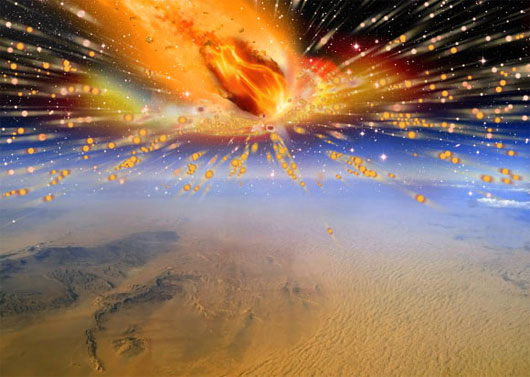Comets cause huge fire rain on Earth
A large comet caused a massive fire rain on Earth 28 million years ago and left its nucleus in the Sahara desert.
A group of South African scientists and international colleagues have found the first solid evidence of a "fire rain" because comets explode when it rushes into the Earth 28 million years ago.
This may not be the explosion that caused the dinosaurs to become extinct, but the terrible fire of the giant comet plunges into the Earth's atmosphere that has destroyed everything in its path, and created a Sea glass stretches over an area of over 6000 square kilometers in the Sahara desert.
Professor Comet David of the University of Witwatersrand in Johanesburg, South Africa said: "Comets often visit Earth, but they are just spheres of dust and ice, we have never found any kind of material. of comets on Earth ".

The giant rain of fire has happened in the Sahara desert.(Photo: sci-news.com)
Knowledge of comets and their impact on planets in the first phase of formation can help scientists find answers to long-lost mysteries around the solar system. our.
Scientists have found this phenomenon after years of analyzing a black pebble discovered by an Egyptian geologist between layers of silicon dioxide caused by the comet explosion. The explosion when this comet collided with the Earth heated the sand layer at the bottom to about 2000 degrees Celsius and turned sand into silicon dioxide. This silicon dioxide sea is a well-known research site because its glass fragments are found on precious jewelry, such as on the first brooch of pharaoh Tutankhamun.
After the study, the scientists discovered that this black pebble is the nucleus of a comet, and is the first comet specimen to be found on Earth. Usually stones like this are just the kind of meteorites that fall on Earth.
"NASA and the European Space Agency have to spend billions of dollars to collect a few micrograms of comet material to return to Earth to study, while we there has been a new direction for this material without having to spend such a lot of money. "
Scientists decided to name this stone Hypatia , after the name of a genius of philosophy, astronomy and mathematics in Alexandria.
This study is being nominated in the journal Earth and Planetary Science Letters , which includes the work of physicists, astronomers, geologists at the University of Wits, the Southern Nuclear Energy Institute. Africa and University of Cape Town.
- Video: Fire storm culprit swept the Earth 12,800 years ago
- Twin comets fly closest to Earth within 250 years
- The biggest fire in history in Chicago
- Comets bring life materials to Earth
- Huge rain of meteorites grows the germ of life on Mars
- What if comets hit the sun?
- If the comet ever destroyed the dinosaurs that hit the Sun, what would happen?
- Comet 'century' approaches the Earth
- Small planets, comets near Earth in 2013
- When the comet is causing
- The most curious mysterious natural phenomena
- The Philae robot sends signals from comets to Earth
 Van Allen's belt and evidence that the Apollo 11 mission to the Moon was myth
Van Allen's belt and evidence that the Apollo 11 mission to the Moon was myth The levels of civilization in the universe (Kardashev scale)
The levels of civilization in the universe (Kardashev scale) Today Mars, the sun and the Earth are aligned
Today Mars, the sun and the Earth are aligned The Amazon owner announced a secret plan to build a space base for thousands of people
The Amazon owner announced a secret plan to build a space base for thousands of people